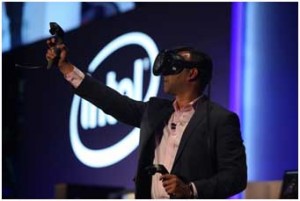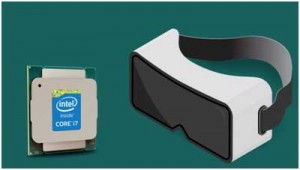The leading tech giant is showing its great interest in mixed reality  headsets and planning to make a chip targeted to these devices. The company feels that in future, headsets may be a rather new class of PCs so there is a huge potential for designing and developing chips dedicated to these devices.
headsets and planning to make a chip targeted to these devices. The company feels that in future, headsets may be a rather new class of PCs so there is a huge potential for designing and developing chips dedicated to these devices.
Intel has started working on this virtual and augmented reality plan. Project Alloy, a Microsoft HoloLens headset, in which Intel also has actively participated, can mix images from real and virtual world. The PC makers will have the Project Alloy to replicate but for Intel, it like opening the new doors for the market of mixed reality headset chips.
Let’s discuss the project Alloy first. It is a prototype headset running on Microsoft’s Window Holographic Platform. It is also providing the base of future development to many VR and AR platforms. The specifications and designs of Alloy will hit the market in the  beginning of 2017. Most of the leading PC makers have already expressed their interest in bringing their headsets based on the design.
beginning of 2017. Most of the leading PC makers have already expressed their interest in bringing their headsets based on the design.
In the words of Venkata Renduchintala, president of the client and internet of things business and System Architecture Group at Intel, “Just like it has done with PCs, Intel is trying to provide guidance to device makers on how to design headsets, integrate hardware, and resolve camera issues, as well as provide ideas on production and productizing”.
Renduchintala, nicknamed Murthy further says “Mixed reality can generate a new class of VR/AR products and will probably generate “a custom piece of silicon built on the PC platform to exemplify and amplify the use case”.
Though Project Alloy headset is loaded with a Skylack laptop chip, but still, the company has no dedicated chip for a headset that are also self-contained computers. On the other hand, while Intel has announced its 7th Generation Core PC chip (named Kaby Lake), but has nothing specific one for all-in-one headset in that lineup.
Intel has a previous history of providing the reference designs for smartphones, laptops, Ultrabooks and 2-in-1s, but in case of Project Alloy, its role is mainly related to open-sourcing. Furthermore, it has already set the tight specifications (such as screen size or thickness) for its product line of handsets and ultrabooks. And, of course the PC makers were required to adere to the specs. The company is wide hopeful that the device makers will easily accept the reference design to mold VR headsets into different shapes and sizes.
The new generation customers are already caught by the VR products like HTC Vive and Oculus Rift, and there is an increasing need to be wired to PC with high end GPUs. Undoubtedly, there is a lot of scope to develop the market in this dimension for both the manufacturers and engineers.
Some actually impressive efforts have been made in this way, for example spurred by HoloLens, PC Style VR and AR headsets. But the problem that the makers are dealing with are: battery life and wireless connectivity. As a smart option, smart phones like Samsung’s GearVR are being placed in headsets.
If we listen to the analyst firms, they are projecting a huge growth in headset shipments, certainly it is a promising sign for Intel who is already stepping forward VR-specific chips. As per the projections by IDC based on the present market demands and online surveys, VR/AR shipments will reach 9.6 million units by the end of the year 2016 and 110 million units by 2020.
It is not the end, Intel is working on more PC style mixed reality experiences over mobile VR. Murthi says “Project Alloy provides a powerful mixed reality experience, and that’s the kind of market Intel wants to develop. What we showed is we can take VR, we can evolve it from the very rudimentary definitions today of running a 99-cent Android app in a smartphone you clip into some kind of visor, you can move it to a 15- to 20-watt powered embedded PC that’s driving two to three teraflops of computing”.









